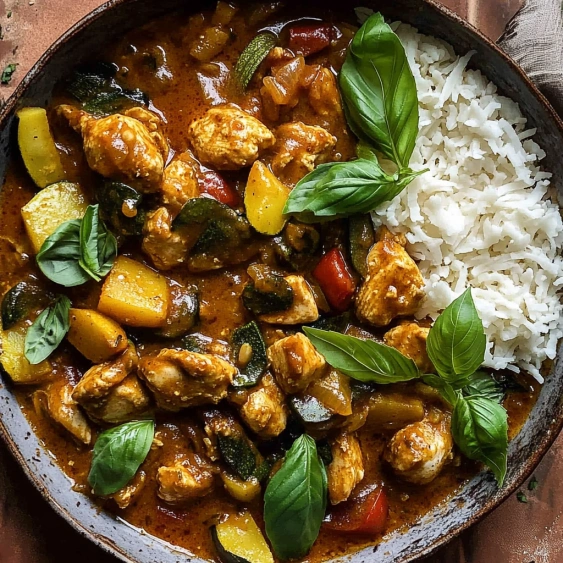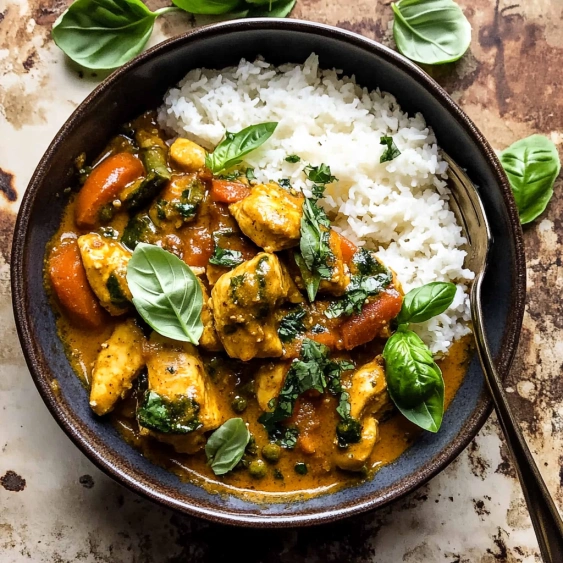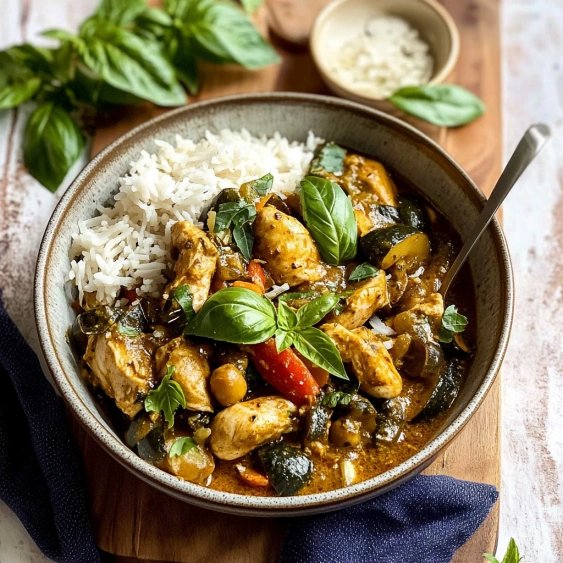 Pin it
Pin it
This spicy coconut basil chicken curry transforms simple ingredients into a vibrant, flavor-packed meal that brings restaurant quality to your dinner table. The aromatic combination of curry spices, creamy coconut milk, and fresh herbs creates a dish that balances heat with sweetness perfectly.
I first created this curry when my garden was overflowing with summer zucchini and basil. What started as a creative way to use garden bounty has become my most requested recipe when friends come over. The way the kitchen fills with fragrant spices always signals a special meal is coming.
Ingredients
- Chicken thighs: Fresh boneless skinless pieces give the best flavor and stay tender in the curry. You can use breast meat but it tends to dry out more easily.
- Yellow curry powder: Provides the foundation of flavor with its warm spice blend. Look for one that smells fragrant when you open the container.
- Turmeric: Adds gorgeous golden color and earthy flavor plus anti-inflammatory benefits.
- Cayenne pepper: Creates the heat level you can easily adjust based on your spice preference.
- Sesame oil: Adds a nutty depth that regular cooking oils simply cannot match.
- Zucchini and corn: Bring freshness and natural sweetness to balance the spice. Choose firm zucchini and fresh summer corn for best results.
- Shallots: Offer a mild garlic onion flavor that creates a perfect base without overpowering.
- Fresh ginger and garlic: Are non-negotiable for authentic flavor. The fresh versions provide brightness that dried versions cannot replicate.
- Coconut milk: Full fat creates the silky richness that makes this curry special. The thinner light versions will not provide the same luxurious texture.
- Fresh herbs: Especially basil and cilantro add brightness that transforms the dish from good to exceptional.
Step-by-Step Instructions
- Season the Chicken:
- Coat the sliced chicken thoroughly in curry powder, turmeric, cayenne, oil, salt and pepper, ensuring each piece is evenly covered. Let this sit for a few minutes while preparing other ingredients to allow the spices to penetrate the meat. The marinade creates a flavorful crust that seals in moisture when cooking.
- Brown the Chicken:
- Heat your skillet until truly hot before adding the chicken. Arrange pieces in a single layer without overcrowding to ensure proper browning. This step creates essential flavor compounds through caramelization that form the backbone of the curry. The chicken should develop golden edges but remain slightly undercooked inside as it will finish cooking later.
- Cook the Vegetables:
- Add zucchini, corn, shallots, garlic, and ginger to the same pan with the chicken. This layering of ingredients allows the vegetables to absorb the flavors already developed in the pan. Cook just until the vegetables begin to soften but still maintain some firmness. The zucchini should be translucent at the edges but not mushy.
- Create the Curry Sauce:
- Pour in coconut milk and water, stirring to incorporate all the browned bits from the bottom of the pan. These caramelized pieces dissolve into the sauce, creating depth. Let the mixture simmer gently, allowing it to thicken naturally as some liquid evaporates. The sauce should coat the back of a spoon but still flow easily when done.
- Finish with Fresh Elements:
- Remove from heat before adding the lemon, cilantro, and basil. The residual heat gently releases the oils in the herbs without cooking away their brightness. Stir thoroughly to distribute these finishing flavors throughout the curry. This final touch transforms the dish from a simple curry to something special with layers of flavor.
 Pin it
Pin it
I discovered the power of fresh basil in this recipe completely by accident. One summer evening when regular Thai basil was unavailable, I substituted Italian basil from my garden, and the aromatic quality it brought to the dish was magnificent. Now I deliberately grow extra basil just for this curry, and the moment those leaves hit the hot curry is truly magical. The entire kitchen fills with an incredible fragrance that always makes everyone ask what smells so amazing.
Choosing the Best Vegetables
While zucchini and corn create a perfect summer version of this curry, the recipe adapts beautifully to whatever vegetables are in season. In fall, try butternut squash and bell peppers. Winter calls for hearty root vegetables like carrots and parsnips. Spring brings opportunities for asparagus and snap peas. The curry base remains the same while the vegetables keep the dish fresh year-round. Whatever you choose, aim for about 3-4 cups total of vegetables for the perfect balance.
 Pin it
Pin it
Spice Level Customization
This curry can be adjusted from mild to fiery depending on your preference. For a family-friendly version, omit the cayenne completely and reduce the red pepper flakes to just a tiny pinch. The curry powder alone provides enough warmth without heat. For spice lovers, increase cayenne to a full teaspoon and double the red pepper flakes. You can also add a diced jalapeño or serrano pepper with the vegetables for fresh heat that builds as you eat.
Serving Suggestions
While basmati rice is the traditional pairing, this curry is remarkably versatile. Try serving it over cauliflower rice for a lower-carb option, or with warm naan bread for scooping up the sauce. For a complete feast, add simple side dishes like a cucumber yogurt salad or quick-pickled vegetables to balance the richness. I sometimes serve smaller portions as a starter before a simple grilled fish main course when entertaining.
Make Ahead and Storage Tips
This curry actually improves with time as the flavors meld together. You can prepare it up to three days ahead and store in the refrigerator in an airtight container. Just reheat gently on the stovetop, adding a splash of water if needed to thin the sauce. For freezing, store without the fresh herbs and add those after reheating for the brightest flavor. Properly stored, the curry freezes well for up to three months.
Frequently Asked Questions
- → Can I make this chicken curry ahead of time?
Yes, this curry actually tastes even better the next day as the flavors have time to develop. Store in an airtight container in the refrigerator for up to 3 days. Reheat gently on the stovetop, adding a splash of water or coconut milk if needed to thin the sauce.
- → What vegetables can I substitute in this curry?
This curry is very adaptable. Try bell peppers, green beans, eggplant, spinach, or carrots instead of or in addition to the zucchini and corn. Adjust cooking times accordingly as harder vegetables will need longer to soften.
- → Can I make this curry vegetarian?
Absolutely! Replace the chicken with firm tofu, chickpeas, or additional vegetables. For extra flavor, roast the tofu or vegetables before adding them to the curry.
- → How can I adjust the spice level?
Control the heat by adjusting the amount of cayenne pepper and red pepper flakes. For a milder curry, reduce or omit these spices. For extra heat, add a finely chopped fresh chili or a dash of hot sauce at the end of cooking.
- → What can I serve with this curry besides rice?
This curry pairs beautifully with naan bread, quinoa, cauliflower rice for a low-carb option, or even rice noodles. A side of cucumber raita or yogurt can help balance the spiciness.
- → Is this curry gluten-free?
The curry itself is naturally gluten-free, but always check your curry powder ingredients as some blends may contain gluten. Ensure all other packaged ingredients are certified gluten-free if serving to someone with celiac disease or gluten sensitivity.
